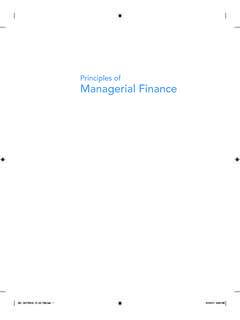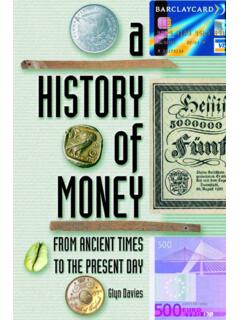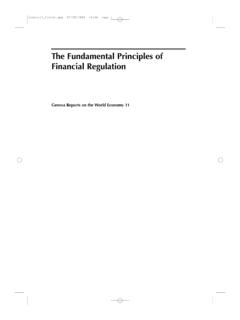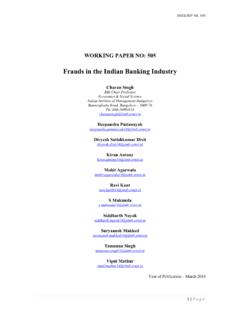Transcription of Macroeconomics - Jolly Green General
1 Macroeconomics . This page intentionally left blank S E V E N T H E D I T I O N. Macroeconomics . N. GREGORY MANKIW. Harvard University Worth Publishers Senior Publishers: Catherine Woods and Craig Bleyer Senior Acquisitions Editor: Sarah Dorger Senior Marketing Manager: Scott Guile Consulting Editor: Paul Shensa Senior Development Editor: Marie McHale Development Editor: Jane Tufts Assistant Editor, Media and Supplements: Tom Acox Associate Managing Editor: Tracey Kuehn Project Editor: Dana Kasowitz Art Director: Babs Reingold Cover and Text Designer: Kevin Kall Production Manager: Barbara Anne Seixas Composition: TSI Graphics Printing and Binding: RR Donnelley Cover art: Barbara Ellmann WHAT'S YOUR ANGLE? Encaustic on Wood Panel 24'' x 24'' 2005. Library of Congress Cataloging-in-Publication Number: 2009924581. ISBN-13: 978-1-4292-1887-0. ISBN-10: 1-4292-1887-8. 2010, 2007, 2003 by N. Gregory Mankiw All rights reserved. Printed in the United States of America First Printing 2009.
2 Worth Publishers 41 Madison Avenue New York, NY 10010. about the author Photo by Deborah Mankiw N. Gregory Mankiw is Professor of Economics at Harvard University. He began his study of economics at Princeton University, where he received an in 1980. After earning a in economics from MIT, he began teaching at Harvard in 1985 and was promoted to full professor in 1987. Today, he regularly teaches both undergraduate and graduate courses in Macroeconomics . He is also author of the popular introductory textbook Principles of Economics (Cengage Learning). Professor Mankiw is a regular participant in academic and policy debates. His research ranges across Macroeconomics and includes work on price adjustment, consumer behavior, financial markets, monetary and fiscal policy, and economic growth. In addition to his duties at Harvard, he has been a research associate of the National Bureau of economic Research, a member of the Brookings Panel on economic Activity, and an adviser to the Federal Reserve Bank of Boston and the Congressional Budget Office.
3 From 2003 to 2005 he was chairman of the President's Council of economic Advisers. Professor Mankiw lives in Wellesley, Massachusetts, with his wife, Deborah;. children, Catherine, Nicholas, and Peter; and their border terrier, Tobin. v To Deborah T. hose branches of politics, or of the laws of social life, on which there exists a collection of facts sufficiently sifted and methodized to form the beginning of a science should be taught ex professo. Among the chief of these is Political Economy, the sources and conditions of wealth and material prosperity for aggregate bodies of human beings.. The same persons who cry down Logic will generally warn you against Polit- ical Economy. It is unfeeling, they will tell you. It recognises unpleasant facts. For my part, the most unfeeling thing I know of is the law of gravitation: it breaks the neck of the best and most amiable person without scruple, if he forgets for a single moment to give heed to it. The winds and waves too are very unfeeling.
4 Would you advise those who go to sea to deny the winds and waves or to make use of them, and find the means of guarding against their dangers? My advice to you is to study the great writers on Political Economy, and hold firmly by what- ever in them you find true; and depend upon it that if you are not selfish or hard- hearted already, Political Economy will not make you so. John Stuart Mill, 1867. brief contents Preface xxiii Supplements and Media xxxii part I Chapter 11 Aggregate Demand II: Applying the Introduction 1 IS LM Model 311. Chapter 12 The Open Economy Revisited: The Chapter 1 The Science of Macroeconomics 3. Mundell Fleming Model and the Chapter 2 The Data of Macroeconomics 17 Exchange-Rate Regime 339. Chapter 13 Aggregate Supply and the Short-Run Tradeoff Between Inflation and part II Unemployment 379. Classical Theory: The Economy in the Chapter 14 A Dynamic Model of Aggregate Long Run 43 Demand and Aggregate Supply 409. Chapter 3 National Income: Where It Comes From and Where It Goes 45.
5 Chapter 4 money and Inflation 79. part V. Chapter 5 The Open Economy 119 Macroeconomic Policy Debates 443. Chapter 6 Unemployment 163 Chapter 15 Stabilization Policy 445. Chapter 16 Government Debt and Budget Deficits 467. part III. Growth Theory: The Economy in the Very Long Run 189 part VI. Chapter 7 economic Growth I: Capital More on the Microeconomics Behind Accumulation and Population Macroeconomics 493. Growth 191 Chapter 17 Consumption 495. Chapter 8 economic Growth II: Technology, Chapter 18 Investment 525. Empirics, and Policy 221 Chapter 19 money Supply, money Demand, and the banking System 547. part IV. Epilogue What We Know, What We Don't 567. Business Cycle Theory: The Economy in the Short Run 255. Glossary 575. Chapter 9 Introduction to economic Fluctuations 257 Index 585. Chapter 10 Aggregate Demand I: Building the IS LM Model 287. viii |. contents Preface xxiii Supplements and Media xxxii part I Introduction 1. Chapter 1 The Science of Macroeconomics 3. 1-1 What Macroeconomists Study 3.
6 CASE STUDY The Historical Performance of the Economy 4. 1-2 How Economists Think 7. Theory as Model Building 7. FYI Using Functions to Express Relationships Among Variables 11. The Use of Multiple Models 12. Prices: Flexible Versus Sticky 12. Microeconomic Thinking and Macroeconomic Models 13. FYI Nobel Macroeconomists 14. 1-3 How This Book Proceeds 15. Chapter 2 The Data of Macroeconomics 17. 2-1 Measuring the Value of economic Activity: Gross Domestic Product 18. Income, Expenditure, and the Circular Flow 18. FYI Stocks and Flows 20. Rules for Computing GDP 20. Real GDP Versus Nominal GDP 23. The GDP Deflator 25. Chain-Weighted Measures of Real GDP 25. FYI Two Arithmetic Tricks for Working With Percentage Changes 26. The Components of Expenditure 27. FYI What Is Investment? 28. CASE STUDY GDP and Its Components 28. Other Measures of Income 29. Seasonal Adjustment 31. 2-2 Measuring the Cost of Living: The Consumer Price Index 32. The Price of a Basket of Goods 32. The CPI Versus the GDP Deflator 33.
7 CASE STUDY Does the CPI Overstate Inflation? 35. 2-3 Measuring Joblessness: The Unemployment Rate 36. The Household Survey 36. | ix x | Contents CASE STUDY Trends in Labor-Force Participation 38. The Establishment Survey 39. 2-4 Conclusion: From economic Statistics to economic Models 40. part II Classical Theory: The Economy in the Long Run 43. Chapter 3 National Income: Where It Comes From and Where It Goes 45. 3-1 What Determines the Total Production of Goods and Services? 47. The Factors of Production 47. The Production Function 48. The Supply of Goods and Services 48. 3-2 How Is National Income Distributed to the Factors of Production? 49. Factor Prices 49. The Decisions Facing the Competitive Firm 50. The Firm's Demand for Factors 51. The Division of National Income 54. CASE STUDY The Black Death and Factor Prices 56. The Cobb Douglas Production Function 56. CASE STUDY Labor Productivity as the Key Determinant of Real Wages 59. 3-3 What Determines the Demand for Goods and Services?
8 60. Consumption 61. Investment 62. FYI The Many Different Interest Rates 64. Government Purchases 64. 3-4 What Brings the Supply and Demand for Goods and Services Into Equilibrium? 65. Equilibrium in the market for Goods and Services: The Supply and Demand for the Economy's Output 66. Equilibrium in the financial Markets: The Supply and Demand for Loanable Funds 67. Changes in Saving: The Effects of Fiscal Policy 68. FYI The financial System: Markets, Intermediaries, and the Crisis of 2008 2009 69. CASE STUDY Wars and Interest Rates in the United Kingdom, 1730 1920 70. Changes in Investment Demand 72. 3-5 Conclusion 74. Contents | xi Chapter 4 money and Inflation 79. 4-1 What Is money ? 80. The Functions of money 80. The Types of money 81. CASE STUDY money in a POW Camp 82. The Development of Fiat money 82. CASE STUDY money and Social Conventions on the Island of Yap 83. How the Quantity of money Is Controlled 83. How the Quantity of money Is Measured 84. FYI How Do Credit Cards and Debit Cards Fit Into the Monetary System?
9 85. 4-2 The Quantity Theory of money 86. Transactions and the Quantity Equation 87. From Transactions to Income 87. The money Demand Function and the Quantity Equation 88. The Assumption of Constant Velocity 89. money , Prices, and Inflation 89. CASE STUDY Inflation and money Growth 90. 4-3 Seigniorage: The Revenue From Printing money 92. CASE STUDY Paying for the American Revolution 93. 4-4 Inflation and Interest Rates 94. Two Interest Rates: Real and Nominal 94. The Fisher Effect 94. CASE STUDY Inflation and Nominal Interest Rates 95. Two Real Interest Rates: Ex Ante and Ex Post 96. CASE STUDY Nominal Interest Rates in the Nineteenth Century 97. 4-5 The Nominal Interest Rate and the Demand for money 98. The Cost of Holding money 98. Future money and Current Prices 98. 4-6 The Social Costs of Inflation 100. The Layman's View and the Classical Response 100. CASE STUDY What Economists and the Public Say About Inflation 101. The Costs of Expected Inflation 102. The Costs of Unexpected Inflation 103.
10 CASE STUDY The Free Silver Movement, the Election of 1896, and the Wizard of Oz 104. One Benefit of Inflation 105. 4-7 Hyperinflation 106. The Costs of Hyperinflation 106. CASE STUDY Life During the Bolivian Hyperinflation 107. The Causes of Hyperinflation 108. CASE STUDY Hyperinflation in Interwar Germany 109. CASE STUDY Hyperinflation in Zimbabwe 111. xii | Contents 4-8 Conclusion: The Classical Dichotomy 112. Appendix: The Cagan Model: How Current and Future money Affect the Price Level 116. Chapter 5 The Open Economy 119. 5-1 The International Flows of Capital and Goods 120. The Role of Net Exports 120. International Capital Flows and the Trade Balance 122. International Flows of Goods and Capital: An Example 124. FYI The Irrelevance of Bilateral Trade Balances 124. 5-2 Saving and Investment in a Small Open Economy 125. Capital Mobility and the World Interest Rate 125. Why Assume a Small Open Economy? 126. The Model 127. How Policies Influence the Trade Balance 128. Evaluating economic Policy 131.





